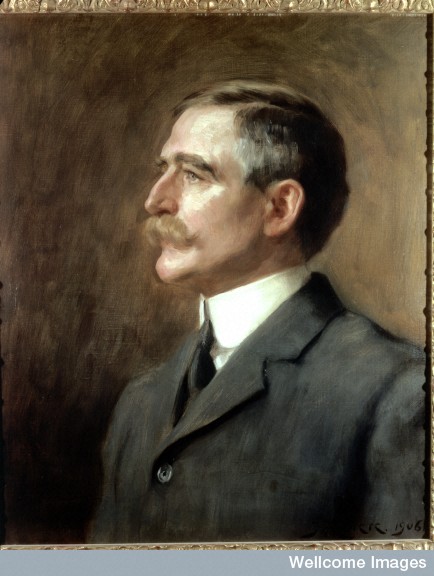- Henry Wellcome
Infobox Medical Person
name = Sir Henry Solomon Wellcome
box_width = 300px
image_width =
caption = Oil painting of Henry Solomon Wellcome in 1906 by Hugh Goldwin Riviere. Provided by [http://images.wellcome.ac.uk/ Wellcome Images] .
birth_date = birth date|1853|8|21|df=y
birth_place =Almond, Wisconsin ,United States
death_date = Death date|1936|7|25|df=y
death_place =London, England
profession = Pharmaceutical Entrepreneur
known_for = FoundingBurroughs Wellcome & Company and theWellcome Trust Sir Henry Solomon Wellcome (
August 21 1853 –July 25 ,1936 ) was an American-British pharmaceutical entrepreneur. He founded the pharmaceutical companyBurroughs Wellcome & Company with his colleague Silas Burroughs, which is one of the four large companies that merged to formGlaxoSmithKline . In addition, he left a large amount of capital for charitable work in his will, which was used to form theWellcome Trust , one of the worlds largest medical charities. He was a keen collector of medical artefacts.Biography
Henry Solomon Wellcome was born in a frontier log cabin in
Almond, Wisconsin to Rev. S. C. Wellcome, an itinerant missionary who traveled and preached in a covered wagon, and Mary Curtis Wellcome. He had an early interest in medicine, particularly marketing. His first product, at the age of 16, was invisible ink (in fact just lemon juice) which he advertised in the Garden City Herald.He was brought up with a strict religious upbringing, particularly with respect to the
temperance movement . His father was a strong member of the SecondAdventist Church. He was a freemason.In 1880, Henry Wellcome established a pharmaceutical company,
Burroughs Wellcome & Company , with his colleague Silas Mainville Burroughs. They introduced the selling of medicine intablet form to England under the 1884trademark "Tabloid"; previously medicines were sold mostly as powders or liquids. They also introduceddirect marketing to doctors, giving them free samples. In 1895, Silas Burroughs died, leaving the company in the hands of his partner. The company flourished and Henry Wellcome set up several research laboratories linked to the drug company.In 1901, he married
Gwendoline Maud Syrie Barnardo , a daughter of orphanage founderThomas John Barnardo . They had one child, Henry Mounteney Wellcome, born 1903, who was sent to foster parents at the age of about three. He was considered to be sickly at the time, and his parents were spending much time traveling.The marriage was not happy, and in 1909 they separated. After that Syrie had several affairs, including with the department store magnate
Harry Gordon Selfridge andWilliam Somerset Maugham with whom she had a child (Mary Elizabeth) and later married. Henry sued for divorce in 1915, naming Maugham as co-respondent. This attracted large amounts of publicity that Wellcome had previously tried to avoid. Syrie never contested Henry's custody of their child.In 1910, Wellcome became a British subject.
In 1924, Henry Wellcome consolidated all his commercial and non-commercial activities in one holding company, The Wellcome Foundation Limited. In 1932, he was knighted and made an Honorary Fellow of the
Royal College of Surgeons of England . He died ofpneumonia inThe London Clinic in 1936 after an operation, and on his death theWellcome Trust was established. In his will, Henry Wellcome vested the entire share capital of his company in individual Trustees, who were charged with spending the income to further human and animal health. TheWellcome Trust is now one of the world's largest private biomedical charities.The first biography of Wellcome was commissioned by the
Wellcome Trust in 1939, by AW Haggis, a member of staff at the Historical Medicine Museum Wellcome had established. However, the Trustees were dissatisfied with the final draft of 1942, and the biography was never published (the drafts are, however, freely available for consultation at the Wellcome Library). To date, the most complete biography of Henry Wellcome is that written by Robert Rhodes James and published in 1994.Collection
Wellcome had a passion for collecting medically related artefacts, aiming to create a Museum of Man. He bought very widely anything related to medicine, including
Napoleon 'stoothbrush , currently on display at theWellcome Collection . By his death there were 125,000 medical objects in the collection, of over one million total. Most of the non-medical objects were dispersed after his death. He was also a keenarchaeologist , in particular digging for many years atJebel Moya inSudan , hiring 4000 people to excavate.Parts of his collection have been exhibited in the
Science Museum (London) since 1976, and in theWellcome Collection as the exhibit "Medicine Man" since 2007. His collection of books, paintings, drawings, photographs and other media are available to view in theWellcome Library .References
*"Henry Wellcome", Robert Rhodes James, Hodder & Stoughton, 1994.
*"The Scandal of Syrie Maugham", Gerald McKnight, W.H. Allen 1980.
* [http://briandeer.com/septrin/henry-wellcome.htm Henry Wellcome by Brian Deer]
* [http://mbbnet.umn.edu/hoff/hsw_art.html Biographical article by William Hoffman]
* [http://library.wellcome.ac.uk/node615.html Wellcome's World - A rich collection of documents at the Wellcome Library in London]
* [http://www.wellcomecollection.org/exhibitionsandevents/exhibitions/medicineman/index.htm Medicine Man at the Wellcome Collection]
Wikimedia Foundation. 2010.
